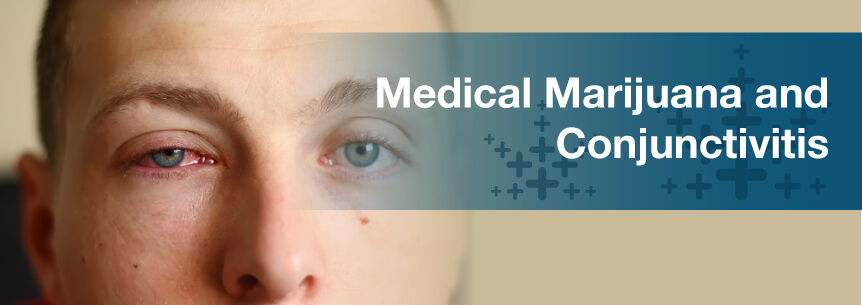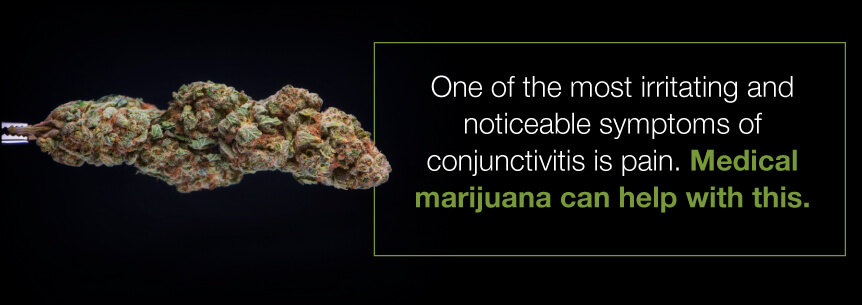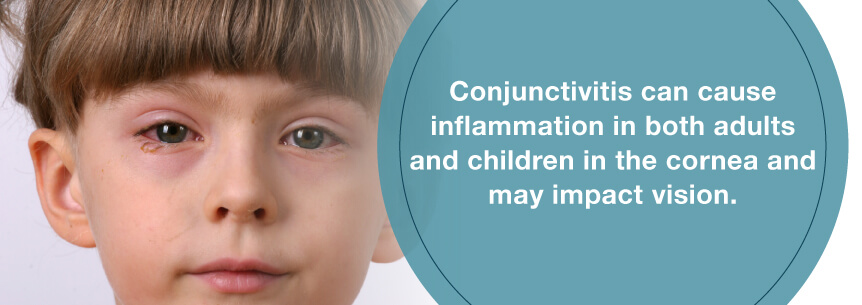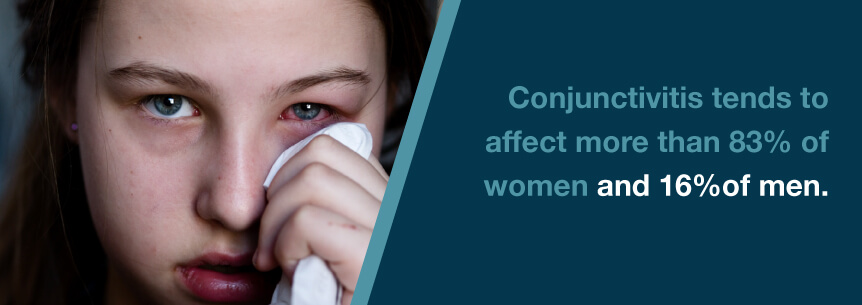
Many people suffering from inflammation are beginning to turn to alternative treatments like medical cannabis for relief. In fact, recent studies now link the herb to reducing pain and inflammation because of its cannabinoid components: CBD and THC. Medical marijuana for conjunctivitis may be a beneficial remedy for you, since the two main symptoms of the condition are pain and inflammation.
Medical cannabis reduces inflammation in your skin and digestive system. It also helps reduce conjunctivitis-related eyelid lining swelling.
Research shows medical cannabis may be a worthwhile treatment for conjunctivitis since pain is its worst symptom and cannabis is also a pain reliever. With conjunctivitis, even if you’re not touching your eyes, you could still experience pain in them.
Find A Doctor Find A Dispensary

Cannabinoids work as powerful anti-inflammatory agents, exerting their effects through inhibition of cell proliferation, induction of apoptosis, induction of T-regulatory cells and suppression of cytokine production. The main mechanism of cannabinoid immunosuppression is immune cell population apoptosis or induction of cell death.
Conjunctivitis can be unbearable due to the constant itch and discomfort. Your experience can get even worse because of the pain, itching, inflammation and the inability to properly open your eyes, causing obstructed vision.
Medical cannabis for conjunctivitis provides palliative care because it relieves pain and reduces inflammation, mitigating the course of the condition and speeding up your recovery. The side effects treatable with marijuana for conjunctivitis include:
The cause of conjunctivitis will dictate what treatment a doctor prescribes. Viruses have no cure, but anti-bacterial drops and antibiotics can fight other types of infection. Medical marijuana can provide palliative care by reducing inflammation and relieving pain.
However, marijuana, in its purest forms, causes eyes to become bloodshot and irritated. Therefore, it can increase those symptoms in many cases of conjunctivitis. It may be necessary to discuss how to ingest medical marijuana so you avoid this side effect. Other types of marijuana are less irritating to the eye. Doctors who prescribe this medication should be able to provide advice on these subjects.
One of the most irritating and noticeable symptoms of conjunctivitis is pain. The affected eye becomes tender to the touch and may ache, even when no pressure is applied. Medical marijuana can help with this. It has properties to reduce sensitivity to pain. This pain relief is not powerful enough to substitute for opiate pain relievers in severe cases of pain.

However, it can relieve the mild to moderate pain associated with conjunctivitis. Animal trials have conclusively shown cannabinoids can alleviate pain. This includes pain due to inflammation, which is what occurs in cases of conjunctivitis. These animal trials show pain due to inflammation is alleviated by cannabinoids because inflammation was the cause of pain in some of the test animals. They exhibited behavior associated with relief from their pain.
Human trials have shown the same results as animal trials. Studies by the University of California, San Francisco, showed a drastic reduction in pain relieving doses of opiates in patients who were taking their medication with medical marijuana. Other studies have shown a moderate dose of marijuana can relieve pain, but the dose has to be right, as too much smoked marijuana seemed to increase pain. Medical marijuana is not the only pain reliever known to do that.
The cause of the discomfort associated with conjunctivitis is the swelling of the eyelid lining. This can be combated by anti-inflammatory medication. Research into medical marijuana and digestive disorders has shown medical marijuana can alleviate inflammation in the digestive system. It also reduces inflammation of the skin, according to anecdotal evidence.
These anti-inflammatory properties appear to be able to work without the use of endocannabinoid receptors, which are the main system in which medical marijuana works. It appears the pain-relieving properties of medical marijuana may be able to do this also. If so, they could relieve pain and inflammation in areas of the body that do not contain endocannabinoid receptors.
One study reportedly showed medical marijuana can relieve itching. Twenty-five hundred people with itching were given medical marijuana to relieve itching caused by eczema. It eliminated eczema within three weeks for more than 38 percent of those individuals. More importantly for those suffering from conjunctivitis, it was able to relieve itching in those individuals and provide some relief for roughly half of the individuals who participated.
Some good inflammation-fighting strains include the following:
Any therapy should be undertaken with the guidance of a healthcare professional or medical doctor with the proper training, acumen and experience. Today, doctors recommend cannabis more often and substitute it for prescription medication with addictive properties and serious side effects. Different delivery methods for cannabis and conjunctivitis treatment include:
Keep in mind that when smoking cannabis, a common side effect is irritated and bloodshot eyes. Therefore, if your doctor prescribes you marijuana for conjunctivitis treatment, you need to choose the delivery method carefully.
While medical marijuana for conjunctivitis might not cure your conjunctivitis, it is a useful solution for treating your symptoms when you’re suffering from this ailment. To get your prescription and medical marijuana card, search for a medical marijuana doctor and locate a cannabis dispensary today.
Find A Doctor Find A Dispensary
Conjunctivitis, also called pink eye, is inflammation of your conjunctiva (inside of your eyelids) and the clear, thin top cover of the white (sclera) of your eyes. Despite being transparent, your conjunctiva has blood vessels covering your eye sclera.
Inflammation causes dilation of your conjunctival blood vessels. This leads to bloodshot, reddened eyes. While there are a few causes of conjunctivitis, physicians use the word “pink eye” mainly in cases of viral conjunctivitis.
The primary forms of conjunctivitis, depending on the cause, include:
Since it’s among the most active areas of allergic inflammation due to not having a fixed barrier to protect against pollen or other allergens on its surface, the eyes have become the focus of extreme pharmacologic development.
There’s been astounding advances and growth in therapeutic medicine over the past 20 years. These range from aspirin byproducts to numerous biological immunomodulatory developments using implantable drug delivery devices exceeding the effectiveness and safety of the different organ systems. Doctors are also utilizing advanced surgical techniques to correct disease-related, sight-threatening complications.
Above all, doctors are now able to manage ocular inflammation better due to the increasing knowledge base. The clinical immunologist or allergist plays a significant role in the prognosis of patients with ocular surface anterior inflammatory disorders — particularly allergic conjunctivitis.
Common symptoms of conjunctivitis include:
While pink eye is typically the cause of eye redness, other severe eye ailments can cause this redness as well as eye pain, light sensitivity or blurred vision. If you notice any of these symptoms and suspect conjunctivitis, have your doctor take a look at it. As mentioned, this condition can be extremely contagious for as long as a couple of weeks after you’ve begun symptoms. Receiving an early diagnosis and treatment can also help protect those around you from getting the condition.
Conjunctivitis can cause inflammation in both adults and children in the cornea and may impact vision. To reduce your risk of further complications, be sure to have your doctor exam you right away and prescribe you treatment.

Conjunctivitis complications will depend on if your pink eye is allergy-related (allergic conjunctivitis) or an infection (infective conjunctivitis).
If chlamydia or another sexually transmitted infection is causing your conjunctivitis, the infection can last a few months instead of a couple of weeks. Any bacteria causing infective conjunctivitis can lead to numerous complications, especially in premature newborns. Other potential complications may include:
It’s rare for anyone to experience severe complications with allergic conjunctivitis, but you may find it frustrating to continue having recurring symptoms. For instance, if pollen is causing your conjunctivitis, it can keep you from going outside in the summer or spring months, since it can trigger symptoms.
Allergic conjunctivitis can make it hard to concentrate at school or work — especially if you’re dealing with seriously irritated eyes. It can affect daily living, too. While allergic conjunctivitis doesn’t normally result in any long-term health issues, it can affect your quality of life.
Different forms of conjunctivitis may bring on keratitis. This is where the front of your eye (cornea) becomes inflamed, painful and causes photophobia (eye sensitivity to light). You may form ulcers on your cornea, which can cause scarring and even lead to permanent vision damage.
Individuals with anxiety and stress often get conjunctivitis — particularly females between the ages of 50 through 59 years old with depression and taking Xanax. Conjunctivitis tends to affect more than 83 percent of women and 16 percent of men.

The National Institutes of Health Reports:
There are three primary goals of treating pink eye. These are:
The treatment you receive will depend on what’s causing your conjunctivitis.
The doctor typically treats bacterial conjunctivitis with antibiotic eye ointments or drops. You should notice some improvement after three to four days of treatment. However, you need to take the whole course of antibiotics regardless of this improvement or you could have a recurrence.
Your first step, if possible, is to avoid or remove the irritant. Artificial tears and cool compresses may relieve your discomfort if you have a mild case of allergic conjunctivitis. If you have a severe case, your doctor may prescribe you antihistamines or nonsteroidal anti-inflammatory medicines. If your allergic conjunctivitis is persistent, you may need topical steroid eye drops as well.
Standard treatment for this type of conjunctivitis is flushing your eyes out carefully with saline. You may also need topical steroids with chemical conjunctivitis. If your chemical injury is severe, such as with alkali burns, you will need immediate medical care, since it can lead to:
If you spill a chemical in your eye, immediately flush your eye out for a few minutes with water before you seek medical attention.
Ointments or drops can’t treat this type of conjunctivitis and antibiotics won’t cure it. Since viral conjunctivitis is a virus (like a cold), it will need to simply run its course, taking anywhere from two to three weeks. You may use artificial tear drops or cool compresses to relieve the symptoms. Your doctor may prescribe topical steroid drops, if your case is severe, to help reduce inflammation-related discomfort. Note that these drops are only meant to soothe the symptoms — not shorten the infection.